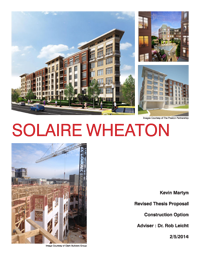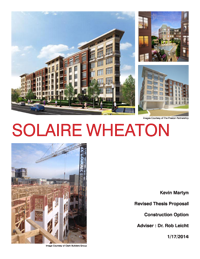|
THESIS PROPOSAL
|
REVISED THESIS PROPOSAL
FEBRUARY 5TH, 2014 |
ANALYSIS 1: SELF-WRITTEN VS. FORM CONTRACT WEATHER CLAUSE
Contract clause ambiguity in the owner contractor agreement was expressed by the project team as a
challenge, particularly the weather clause. This analysis will interpret the self-written weather clause to
that of form contracts in an effort to determine the most practical contract language. A recommendation
will then be made to change the contract language to eliminate the ambiguities.
|
 |
ANALSYSIS 2: CRITICAL INDUSTRY ISSUE: SITE SPECIFIC SAFETY ORIENTATION
The critical industry issue of site specific safety orientation will be the topic of the second analysis,
which investigates current approaches to safety orientation. The generic training videos and lengthy
site specific safety plan documents are unable to effectively inform workers of the hazards they will
encounter and their locations within the jobsite. The use of building information modeling will provide
a more effective means of presenting safety information, as 83% of what we learn derives from what we
see. This analysis will investigate effective ways to add value to the project safety orientation though
the use of building information modeling.
|
ANALYSIS 3: MODULARIZATION
With competing developers building apartments nearby, the main goal of the owner is to finish as
soon as possible and sign lease agreements. Had there been a way to accelerate the schedule, the
owner most likely would have approved the process, even with a potential cost increase. This analysis
will determine the feasibility of implementing modularization on the Solaire Wheaton project. The
podium structure design allows for the wood framed units to be constructed off-site and concurrent
with foundation and reinforced concrete work. This construction method should reduce the current
construction schedule by several weeks while providing a safer means of construction and less material
waste.
|
REVISED THESIS PROPOSAL
JANUARY 17TH, 2014 |
 |
ANALYSIS 4: SIPS FOR INTERIOR FINISHES
Phase two of the project involves completing the interior finishes on floors three through six, while the
building is potentially occupied. For obvious reasons, the contractor would like to turnover this phase
as quickly as possible. The critical path method for scheduling does not provide a predictable schedule
duration and is typically not met by contractors. Short interval production scheduling is a scheduling
technique that is derived from accurate production rates, and therefore is more easily attainable. This
analysis will implement SIPS on the interior finishes to better plan, manage, and track activities.
|
ARCHITECTURAL BREADTH
The third analysis to determine the feasibility of modularization on the Solaire project will require an
architectural layout redesign. Modularization is most effective on repetitive processes; however, the
current design incorporates twenty-one different unit layouts. Performing an architectural breadth to
reduce the number of layouts to a single digit number will make modularization more effective. Every
effort will be made to preserve the architectural features, particularly the facade projections. A typical
floor will be analyzed as floors three through six have the same layout.
The deliverables will be graphical representations of the final unit layouts, a typical floor plan, and
elevation renderings to compare the aesthetics in the facade projections.
|
ORIGINAL THESIS PROPOSAL
DECEMBER 16TH, 2013 |
 |
STRUCTURAL BREADTH
To aid in determining the plausibility of modularization in analysis three, a structural breadth will analyze the performance of the crane to be used for setting the modular units. Although modular units are typically set using a mobile crane, the site restrictions make this an unlikely possibility. In addition, the tower crane will still be in place from the structural concrete phase. It is presumed that due to the large loads associated with modular units, the tower crane and foundation pad will need to increase in size and strength.
The deliverables for this breadth will be an analysis of the crane reach and strength based on the estimated weight of the modular units. If necessary, the crane will be resized to meet these parameters. This will then be followed by calculations to size the crane foundation pad and its reinforcement.
|
MAE REQUIREMENTS
The knowledge acquired through the construction integrated masters program has guided the analysis
selection process and will provide resources for completing each analysis. Knowledge of construction
and engineering law learned through the AE 598D course will aid in the first analysis. The course,
known as Legal Aspects of Engineering and Construction, dealt heavily with design and construction
contracts. Lessons in delay clauses will relate directly to the weather clause analysis.
The AE 570 course, better known as Production Management in Construction, will be applicable to both
the third and fourth analyses. The third analysis of modularization was formed through modularization
techniques learned through the AE 570 course. Modular case studies and technical reports in this
course will aid in the research and implementation of modular construction. The fourth analysis of short
interval production scheduling was also a concept learned through AE 570. The Pentagon Renovation
project was presented in this class and is the model for the implementation of SIPS on the Solaire
Wheaton project.
As part of the mechanical breadth, the study of the enclosure details will involve lessons from the AE
542 course, also known as Building Enclosure Science and Design.
|
|


